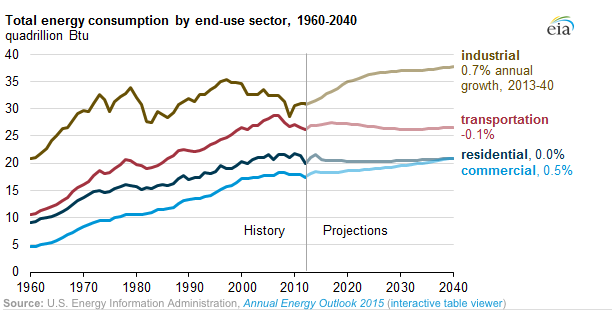Energy consumption in the U.S., which has slowed recently, is projected to inch up by only 0.3% per year through 2040, which would be less than half the projected population growth rate over that period.
In its Annual Energy Outlook 2015, the U.S. Energy Information Administration (EIA) elaborates that industrial energy consumption over the next 25 years will be slightly higher, at 0.7% per year, while annual commercial consumption is expected to be 0.5%.
EIA attributes these consumption reductions to the adoption of energy efficient technologies, as well as “larger structural changes in the economy.” For example, residential consumption has slowed as more people have moved to warmer climates. And policies that have mandated better fuel efficiencies in cars and trucks appear to be having a positive effect.
“These standards, combined with less travel in response to technological and social factors, have reduced transportation energy consumption in recent years and are expected to continue holding transportation consumption nearly flat in the coming decades,” EIA observes.

The department points to several factors that are expected to shape U.S. energy markets in the next generation. These include:
- Growth in U.S. energy production, coupled with only modest increases in domestic demand, will further reduce the country’s reliance on imported energy suppliers. EIA anticipates that energy imports and exports “come into balance” in the U.S. starting in 2028.
- The U.S. will transition from being a modest net importer of natural gas to a net exporter by 2017, with net exports in 2040 ranging from 3 trillion cubic feet (in a low-oil-price scenario) to 13.1 million (in a high oil and gas resource scenario).
- Rising costs for electric power generation, transmission, and distribution, along with slower growth in electricity demand, are expected to lead to an 18% increase in the average retail price of electricity between 2013 and 2040.
- End-user efficiencies are expected to keep energy related carbon dioxide emissions in the U.S. below 2005 levels through 2040.
EIA expects net energy exports to contribute more to the country’s GDP growth than it has in the previous 30 years, partly because of reduced imports. But that impact is also expected to diminish in the later years of this projection cycle, as GDP growth in nations that are U.S. trade partners slows.
Related Stories
Construction Costs | May 16, 2024
New download: BD+C's May 2024 Market Intelligence Report
Building Design+Construction's monthly Market Intelligence Report offers a snapshot of the health of the U.S. building construction industry, including the commercial, multifamily, institutional, and industrial building sectors. This report tracks the latest metrics related to construction spending, demand for design services, contractor backlogs, and material price trends.
K-12 Schools | May 15, 2024
A new Alabama high school supports hands-on, collaborative, and diverse learning
In Gulf Shores, a city on Alabama’s Gulf Coast, a new $137 million high school broke ground in late April and is expected to open in the fall of 2026. Designed by DLR Group and Goodwyn Mills Cawood, the 287,000-sf Gulf Shores High School will offer cutting-edge facilities and hands-on learning opportunities.
Affordable Housing | May 14, 2024
Brooklyn's colorful new affordable housing project includes retail, public spaces
A new affordable housing development located in the fastest growing section of Brooklyn, N.Y., where over half the population lives below the poverty line, transformed a long vacant lot into a community asset. The Van Sinderen Plaza project consists of a newly constructed pair of seven-story buildings totaling 193,665 sf, including 130 affordable units.
University Buildings | May 10, 2024
UNC Chapel Hill’s new medical education building offers seminar rooms and midsize classrooms—and notably, no lecture halls
The University of North Carolina at Chapel Hill has unveiled a new medical education building, Roper Hall. Designed by The S/L/A/M Collaborative (SLAM) and Flad Architects, the UNC School of Medicine’s new building intends to train new generations of physicians through dynamic and active modes of learning.
MFPRO+ News | May 10, 2024
HUD strengthens flood protection rules for new and rebuilt residential buildings
The U.S. Department of Housing and Urban Development (HUD) issued more stringent flood protection requirements for new and rebuilt homes that are developed with, or financed with, federal funds. The rule strengthens standards by increasing elevations and flood-proofing requirements of new properties in areas at risk of flooding.
Government Buildings | May 10, 2024
New federal buildings must be all-electric by 2030
A new Biden Administration rule bans the use of fossil fuels in new federal buildings beginning in 2030. The announcement came despite longstanding opposition to the rule by the natural gas industry.
Mass Timber | May 8, 2024
Portland's Timberview VIII mass timber multifamily development will offer more than 100 affordable units
An eight-story, 72,000-sf mass timber apartment building in Portland, Ore., topped out this winter and will soon offer over 100 affordable units. The structure is the tallest affordable housing mass timber building and the first Type IV-C affordable housing building in the city.
K-12 Schools | May 7, 2024
World's first K-12 school to achieve both LEED for Schools Platinum and WELL Platinum
A new K-12 school in Washington, D.C., is the first school in the world to achieve both LEED for Schools Platinum and WELL Platinum, according to its architect, Perkins Eastman. The John Lewis Elementary School is also the first school in the District of Columbia designed to achieve net-zero energy (NZE).
Healthcare Facilities | May 6, 2024
Hospital construction costs for 2024
Data from Gordian breaks down the average cost per square foot for a three-story hospital across 10 U.S. cities.
MFPRO+ Special Reports | May 6, 2024
Top 10 trends in affordable housing
Among affordable housing developers today, there’s one commonality tying projects together: uncertainty. AEC firms share their latest insights and philosophies on the future of affordable housing in BD+C's 2023 Multifamily Annual Report.

















